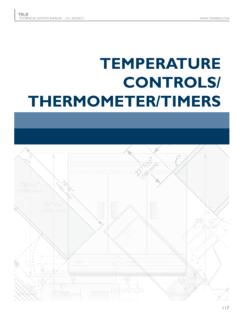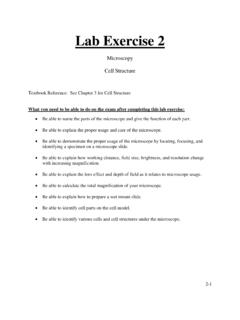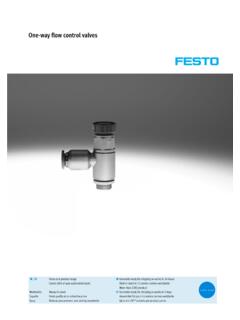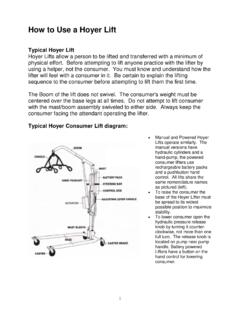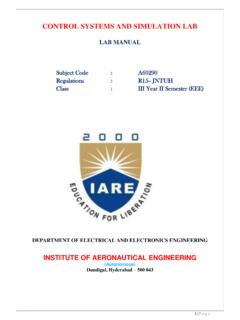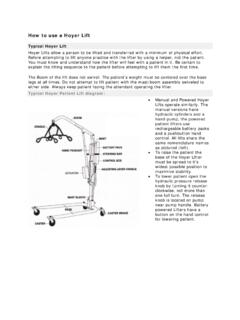Transcription of Definitions of the Parts of the Microscope - ualberta.ca
1 - page 1 - Definitions of the Parts of the Microscope Heather KroeningMay 2001 Arm - The arm of the Microscope supports the body tube. Body Tube - The body tube is a hollow tube through which light travels from the objective to the ocular. It contains a prism at the base of the tube that bends the light rays so they can enter the inclined tube. Coarse Adjustment knob - The coarse adjustment knob located on the arm of the Microscope moves the stage up and down to bring the specimen into focus. The gearing mechanism of the adjustment produces a large vertical movement of the stage with only a partial revolution of the knob . Because of this, the coarse adjustment should only be used with low power (4X and 10X objectives) and never with the high power lenses (40X and 100X). Condenser Diaphragm - This diaphragm controls the amount of light entering the lens system. This feature is useful for viewing unstained biological specimens that are translucent.
2 Reducing the amount of light improves contrast, making the specimen "stand out" against the background. Some microscopes have an annular condenser, which is a plate under the stage that can be rotated. The plate consists of holes of different diameter. As the plate is rotated, the different holes click into place, blocking out different amounts of light. Other microscopes have an iris diaphragm with a lever that opens and closes the diaphragm to let in varying amounts of light. Use the condenser diaphragm to reduce the amount of light and increase the contrast of the image. Condenser Focusing knob - This control is used to precisely adjust the vertical height of the condenser. Condenser Lens - This lens system is located immediately under the stage and focuses the light on the specimen. control knobs located just behind and underneath the condenser control the up and down movement of the condenser. Field Diaphragm control - The base of the Microscope contains the field diaphragm.
3 This controls the size of the illuminated field. The field diaphragm control is located around the lens located in the base. Fine Adjustment knob - This knob is inside the coarse adjustment knob and is used to bring the specimen into sharp focus under low power and is used for all focusing when using high power lenses. Light Source - The light source in your Microscope is a lamp that you turn on and off using a switch. You can adjust the intensity of light by turning the light adjustment - page 2 - knob . This knob is calibrated with a scale from 1 to 10; 1 is low intensity and 10 is high intensity. Objective Lenses - The objective lens gathers light from the specimen, magnifies the image of the specimen, and projects the magnified image into the body tube. Since no single objective lens can fulfill all the needs of someone using the Microscope , several objective lenses of varying magnification and numerical aperture are mounted on the rotating nosepiece.
4 The nosepiece must click into place for the objective lens to be in proper alignment. You will notice that the lower power lenses (4X and 10X) are shorter than the high power lenses (40X and 100X), meaning that the clearance between the objective lens and the stage is much smaller when the high power lenses are clicked into place. You must be very careful when using the high power lenses so you do not jam them into the slide. Ocular Lens - The ocular lens, or eyepiece, magnifies the image. It contains a measuring scale called and ocular micrometer. The ocular micrometer has no units. Revolving Nose Piece - Several objective lenses of varying magnification and numerical aperture are mounted on the revolving nosepiece. The nosepiece must click into place for the objective lens to be in proper alignment. Stage - The horizontal surface upon which the slide is placed is called the stage. The slide is held in place by spring loaded clips and moved around the stage by turning the geared knobs on the stage.
5 The stage has two perpendicular scales that can be used to record the position of an object on a slide. This is useful if you want to quickly relocate an object. copyright 2001 by Heather Kroening, and Bio-DiTRL (see detailed terms of use at ).
